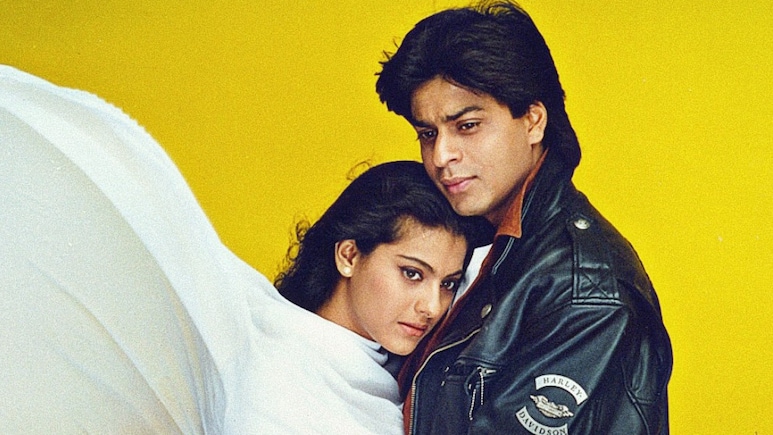
In the heart of Mumbai, tucked between the chaos of traffic and the aroma of cutting chai, stands a theatre that has defied time - Maratha Mandir. Its old-world charm greets you even before you enter - the classic marquee letters, the faded posters, the single-screen aura that's slowly disappearing from the city's skyline. But step inside, and you realise something extraordinary - here, love still plays every day at 11:30 AM sharp.
For thirty years now, Dilwale Dulhania Le Jayenge - or DDLJ, as an entire generation lovingly calls it - has been running at this very theatre. Not just running but thriving. In a city where every Friday brings a new release and where cinematic fads change faster than Instagram trends, DDLJ continues to pull in crowds, sometimes outnumbering newer films.
Thirty years on, DDLJ isn't just a film that runs - it's a heartbeat that refuses to fade.
It's Diwali, and while India woke up to festive rituals, a few chose to start their day with their first love - cinema. Outside Maratha Mandir, it was a different kind of festival. The film's 30th anniversary had turned the usually quiet morning show into a celebration. A crowd gathered well before showtime - some clutching tickets, others posing for photos in front of the iconic poster. There were hand-painted placards, posters, and a line that snaked around the theatre entrance.
Among the crowd stood a father who first watched DDLJ at Maratha Mandir when he was sixteen. He was back now with his wife - who was watching it here for the first time - and their three kids, aged ten, seven, and three.
"I wanted them to feel what we did," he said, smiling. "Watching DDLJ here is not just watching a movie, it's an experience."
Another father had travelled over 2,000 kilometres from Shantiniketan, West Bengal, with his teenage daughter.
"She's interested in acting and is a huge SRK fan," he said proudly, holding up his ticket. "When she said she wanted to watch DDLJ on the big screen, I decided to bring her here. We need to change with time, but some films are timeless."
A woman standing in the queue held up a Swiss cowbell. When asked about it later, she smiled and said, "I travelled to Switzerland just to visit all the DDLJ locations. This bell is from the same shop where Raj buys it for Simran. Watching the film again here feels like coming full circle."
There were also three Swiss tourists in line, each holding their ticket with excitement.
"We knew about this film and that parts of it were shot in Switzerland," one of them said. "But watching it here, in this theatre, is different. SRK is a legend."
Inside the theatre, the nostalgia deepened. The familiar smell of popcorn, the faint creak of wooden seats, the aroma of oily samosas - everything felt like stepping back in time. The moment the opening notes of Mere Khwabon Mein Jo Aaye filled the hall, the crowd erupted. It's Kajol's introduction song, but the cheers were reserved for Shah Rukh Khan's grand entry as Raj. When he finally appears on screen, arms wide open, the theatre broke into applause and whistles.
When Raj extended his hand to Simran in that legendary train scene, the hall turned into a sea of cheers. Dialogues were spoken in unison, every punchline met with applause, every emotional moment followed by sighs. Songs like Tujhe Dekha Toh Yeh Jaana Sanam became collective karaoke sessions - strangers singing together, eyes lit with joy.
Through the doors, you could hear the film's dialogues and songs spilling into the theatre lobby. In a dimly lit corner office sat Manoj Pandey, the manager of Maratha Mandir for over two decades.
Speaking about the moment, he said, "We want people to enjoy, so we've never increased the prices - stalls are still Rs 30, and balcony seats Rs 50. When the film first released, it came as a physical print; now it's digital. We've evolved with time, so the audience keeps enjoying it. There are days when DDLJ has more audience than new releases."
As the end credits rolled, no one rushed to leave. People stood, clapping, smiling, some taking photos of the screen as if to capture the feeling forever. Outside, fans brought out a cake with the film's iconic scene - Raj and Simran embracing in the yellow mustard fields - printed on it, cutting it to mark 30 years of love, cinema, and magic.
Because inside Maratha Mandir, it isn't just a movie playing - it's a ritual, a shared memory, a timeless story that continues to unite generations.
Even after three decades, Dilwale Dulhania Le Jayenge remains what it has always been - a celebration of love, of cinema, and of that undying hope that somewhere, someone will still say, "Bade bade deshon mein aisi chhoti chhoti baatein hoti rehti hain."
And at Maratha Mandir, that love story still plays on.
ALSO READ | Weekend Binge: Celebrate 30 Years Of DDLJ With New-Age Rom-Coms

